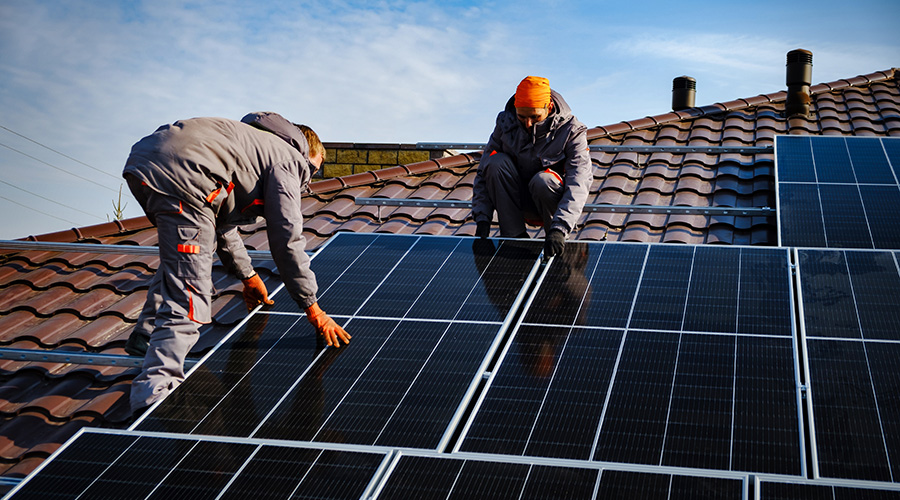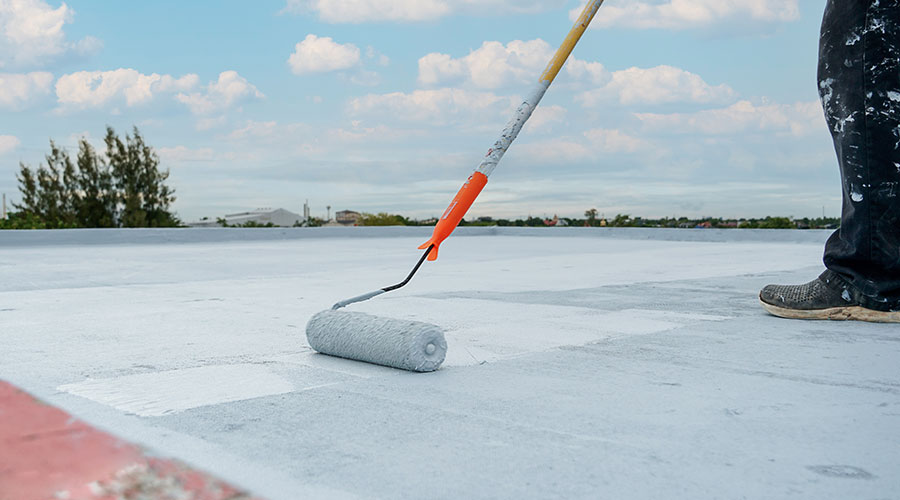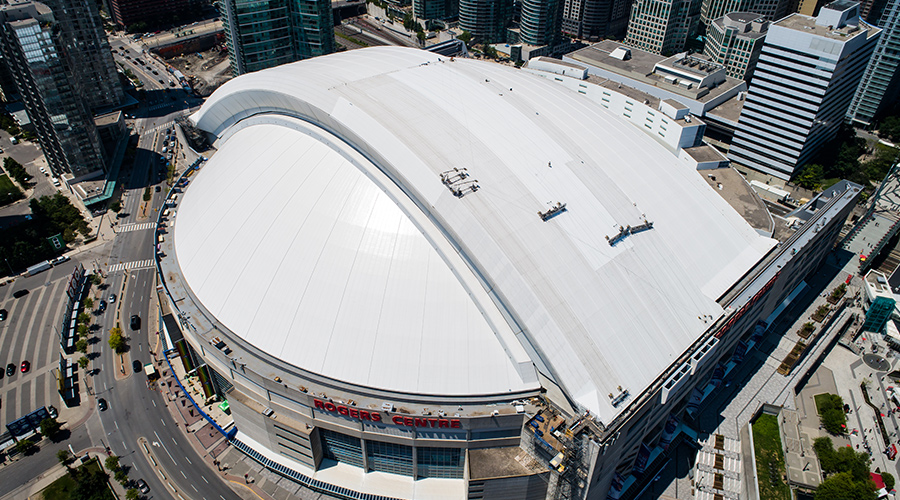Will Your Roof Weather a Storm?
Many types of roof systems perform well in high winds. Still, knowing how to prepare improves the odds a roof will survive.
What happens when high velocity winds meet low slope roofs? There’s no simple answer, and no way to predict exactly which roofs will have trouble, even after years of experience with roof damage caused by hurricanes. Sometimes, on buildings with the same type of roof that are located side by side, one roof blows off or suffers other catastrophic damage while the other roof has very little damage.
Of roofs that remained in place, the best performers were conventional built-up or modified bitumen membranes fully adhered to a structural concrete deck. Most had puncture damage to flashings and cuts as a result of flying debris, but the roofs stayed intact and in place. The gravel-surfaced, built-up roofs fared slightly better than the modified bitumen systems because the gravel that was well embedded in the flood coat provided protection from flying debris. The weight of the gravel also helped keep the roof down. Unfortunately, most of the built-up roofs lost a good portion of the gravel surfacing, causing other damage to surrounding buildings, but the roofs that the gravel came from suffered the least amount of punctures.
Less effective, but still good, were the modified bitumen and built-up systems mechanically attached to steel decks. The asphalt-based roof systems that were attached to lightweight concrete or gypsum deck tended to have more wind-related damage than others. Generally, the membrane stayed intact, but sections pulled up from the deck, leaving the membrane loose on the roof but looking as if nothing had happened to it. With lightweight concrete and gypsum decks, whether the roof stayed in place mostly depended on the condition of the lightweight concrete or gypsum and its ability to resist fastener withdrawal. Older decks were more likely to have damaged roof systems because of the softening of the concrete after long-term water intrusion.
Single-Ply Membranes
Fully adhered single-ply membranes resisted blow off about as well as asphalt systems but were more susceptible to damage from flying debris. Almost all types of flexible membrane systems suffered cuts and punctures during the storms. There was one exception: Roofs that had no mechanical units or other penetrations were usually almost free of puncture damage.
Overall, fully adhered single-ply membranes were more hurricane-resistant than mechanically attached systems. The mechanically attached systems weathered the storms well as long as they remained intact. Once the membrane was cut, the incidence of blown-off membranes increased. The wind was able to get into the cuts, so the roof was subject not only to negative pressure above the membrane — which pulled the membrane up — but also to positive pressure from underneath, which pushed the membrane up.
Because roofs are mostly designed for uplift pressures only, the wind was able to loosen poorly fastened screws. That caused a ripple effect: One screw pulled out, putting extra stress on those around it, which in turn caused them to pull out. That cycle repeated itself until the membrane came all the way off.
When the fasteners stayed in the deck and the membrane was cut, the stress caused by fluttering of the membrane was enough to tear it along the seam like a big zipper. Where no punctures occurred, the roofs stayed in place as well as any other mechanically attached system.
Ballasted systems just plain disappeared.
Metal Roofing Systems
In general, newer standing seam and trapezoidal seam metal roofs were relatively good performers in hurricane winds. The majority of damage was loss of hip and ridge caps. The panels themselves generally stayed in place. When the panels did lift, the damage tended to start at the eaves and where one panel overlapped another at a horizontal seam. Metal systems with mechanically seamed panels stayed watertight more than systems using batten seam covers. The batten covers tended to loosen with the movement of the panels in the wind, allowing water to get under them and into the building.
Although the panels themselves generally stayed in place, as debris hit the batten covers, they rocked and loosened, allowing water to get under the seam cover and into the building.
In either case, roofs with one long panel from ridge to eave stayed better than those with seams across the panels themselves. The seams proved to be weak areas when wind was able to get under the panel and peel it back.
Thicker gauge metal was more resistant to wind than thinner gauge. There did not appear to be any difference in frequency of damage between architectural standing seam and structural standing seam. The only difference is that when the structural standing seam failed, the damage was much more extensive because the structural standing seam roof is not only the waterproofing but also the structure.
Coated polyurethane foam systems are not widely used in Florida, but they have been shown to have excellent wind uplift resistance limited only by the substrate to which the roof is adhered. Although a coated polyurethane foam roof is easily punctured, the foam itself is water-resistant if installed correctly. If the debris does not completely penetrate the foam, the roof remains watertight.
Re-cover Roofs
Re-covered roofs failed at a much higher frequency than new or replacement roofs. The failure was generally at corners where the longer gravel stop used to cover the double membrane edge was not a heavy enough gauge metal to withstand the wind. Consequently, failed re-covers typically peeled back from the corners. The other failure point was within the original roof system, where the original insulation facer delaminated or the insulation just pulled apart. This is logical: The reason the roof was re-covered is that the original roof failed.
Older roofs in general did not stay in place as well as newer roofs. There are two major reasons for this. First, the older materials have aged and in many cases have become brittle and fatigued, leaving them susceptible to puncture damage and wind uplift. Second, until Hurricane Andrew in 1992, wind design was mostly ignored. Only recently has it been accepted as a necessary element of roof design. Older roofs were installed according to codes written prior to research on wind characteristics. As the years have gone by, research has provided a better understanding of wind uplift pressures. Today, the newer codes reflect this research, and roofs are tested to meet actual hurricane wind conditions.
Roof Design
Clearly, the design of the roof must take wind uplift into consideration, but wind uplift is only one aspect of the whole roof design. Using a particular type of roof because it has great uplift resistance is a bad investment if it is unsuitable for its intended use. This is where a competent architectural or engineering roof consultant can help to ensure that the roof is designed not only for wind resistance but also for budget, building characteristics, insurance requirements, code restrictions, fire resistance, climate and all of the other considerations that go into designing a good roof.
No roof will stay in place if the edge and corner conditions are not properly addressed. Most roof failures during windstorms begin at roof terminations: gravel stops and parapets on low slope roofs and ridges, hips and eaves on steep slope roofs. This means that all perimeter edge metal should have continuous cleats — including both gravel stops and copings. The longer the vertical face of the metal, the heavier the gauge it needs to be.
Extra reinforcement is needed around through-wall scuppers. There are many cases where the roof blow-off began, not at a corner where one would normally see damage, but at an overflow at a parapet wall. The wind increases in velocity as it goes through the confined space of the overflow scupper and exerts a greater pressure on the roof membrane as it exits.
Protecting the Roof
What can be done now to protect a building from loss?
- The number one item for protecting a roof against a storm is to be certain that air conditioning unit covers are attached with all the required screws. Most damage to roofs comes from items already on the roof. The worst culprits are mechanical units and their screen enclosures. Air conditioning units, ventilator fans, satellite dishes, antennae and the like are all potential debris during a storm. In one case, Hurricane Andrew sent unsecured 30-ton air conditioning units rolling across a roof. But the most common damage during all of the storms was from air conditioning unit cover panels that were not completely secured. Similarly, ventilator fans lost the covers and antennae lost arms. All of these sharp metal pieces caused long rows of gashes as they blew across the roof and dug into the membrane.
- Put satellite dishes, small air conditioning units and cell phone cable trays on stands and secure them to the structure rather than putting them on wood sleepers or holding them in place with concrete blocks. Concrete blocks and sleepers will blow around in a heavy storm. Strap the equipment to the stand with metal straps to keep them in place.
- Check the lightning protection system to be sure that the cables are well secured to walls and tight on the roof. Be sure the air terminals are well attached to the system. The cables will move during the storm and the air terminals with their sharp points will poke holes in the roof.
- Secure condensate lines. The wood blocks normally used to support condensate lines gouge the roof as the pipes are blown back and forth.
- Check the roof for weak spots like torn flashings and loose perimeter metal accessories. Reinforce weak gravel stops and copings to be sure they will stay in place.
- Clean debris off the roof and check to see that drains are free-flowing and not cluttered with debris. Check gutters and downspouts to be sure they are well-secured and not clogged.
- Know what is on the roof and its current condition. During the past few storms, insurance companies have sometimes denied claims based on prior damage. They argue that they have no way of knowing what damage existed prior to the storm so they are not responsible for any damage that has occurred. A roof survey done by an architectural or engineering roof consultant, one that includes a moisture survey, provides proof that the roof had no damage prior to the storm. And if maintenance is needed, minor repairs can be done beforehand to keep the building as watertight as possible during the storm.
- Don’t wait for a hurricane warning to do these items. There is too much else to do to secure the building to think about the roof.
Hurricanes don’t have to mean a total loss for a roof. If the roof is well-designed — with wind events included as a part of the total package of design parameters — properly installed and well-maintained, it has a solid chance of weathering the storm.
Categorizing Hurricanes
Category 5: Sustained winds of more than 155 mph with storm surges greater than 18 feet. Hurricane Andrew, a category 5 hurricane that struck Florida and Louisiana in 1992, caused more than $26 billion in damages.
Category 4: Sustained winds from 131 to 155 mph with storm surges of 13 to 18 feet. Hurricane Charley, a category 4 storm, left a trail of destruction estimated at $15 billion when it tore through Florida in 2004 — one of four major hurricanes that hit the state that year.
Category 3: Sustained winds from 111 to 130 mph with storm surges of 9 to 12 feet. Two Category 3 storms blasted Florida in 2004: Hurricane Ivan, which also struck Alabama, caused more than $14 billion in damages; the cost of Hurricane Jeanne was estimated at nearly $7 billion.
Category 2: Sustained winds from 96 to 110 mph with storm surges of 6 to 8 feet. The fourth big storm to strike Florida in 2004, Frances, a category 2 hurricane, caused nearly $9 billion in damages.
Category 1: Sustained winds from 74 to 95 mph with storm surges of 4 to 5 feet. The costliest category 1 storm to hit the mainland United States was Agnes, which struck Florida and the Northeastern United States in 1972, causing $1.5 billion in damage.
Source: FEMA. Damage costs available only through 2004.
|
Karen Warseck, AIA, is president of Building Diagnostics Associates, a Hollywood, Fla., architecture firm. She is a contributing editor for Building Operating Management.
Related Topics:











